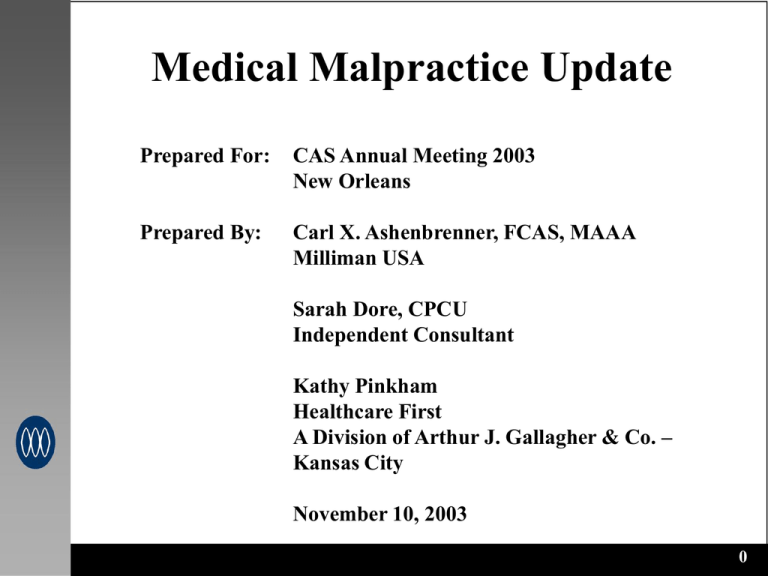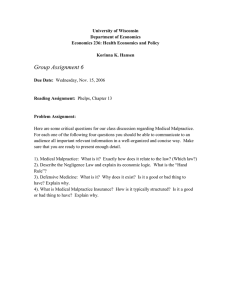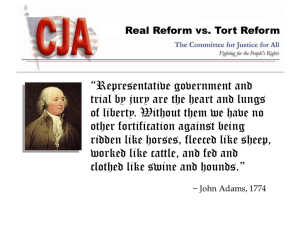Medical Malpractice Update
advertisement

Medical Malpractice Update Prepared For: CAS Annual Meeting 2003 New Orleans Prepared By: Carl X. Ashenbrenner, FCAS, MAAA Milliman USA Sarah Dore, CPCU Independent Consultant Kathy Pinkham Healthcare First A Division of Arthur J. Gallagher & Co. – Kansas City November 10, 2003 00 Overview of Presentation Profile of the National Medical Malpractice Market Current State of the Medical Malpractice Market What the future holds – Solutions and Forecasts Closing Thoughts & Questions Attachments 11 Topic #1: Profile of the National Medical Malpractice Market 22 Property/Casualty Direct Premiums Written by Line - 2002 (Amounts in $000s) $160,000,000 35.34% 34.72% $140,000,000 $120,000,000 $100,000,000 $80,000,000 $60,000,000 10.60% 10.49% $40,000,000 6.66% $20,000,000 2.20% $0 Homeowners Multiple Peril Private-Passenger Commerical Auto Auto Liability & Liability & Physical Damage Physical Damage Medical Malpractice Other Property and Casualty Workers Compensation 33 National Medical Malpractice Market Growth Direct Written Premium Nationalin Medical Malpractice Market Growth in Direct Written Premium Direct Written Premium (Billions) 22.5% $9 $8 15.6% $7 9.7% $6 9.8% $5 3.2% (4.6%) (3.0%) 3.9% 4.9% 6.7% 26.5% $4 52.8% $3 $2 6.5% 3.2% (1.5%) (0.9%) 3.0% (0.4%) 5.9% 4.9% 11,4% 5.2% 13.2% $1 $0 1979 1980 1981 1982 1983 1984 1985 1986 1987 1988 1989 1990 1991 1992 1993 1994 1995 1996 1997 1998 1999 2000 2001 2002 *Estimated per A.M. Best using net written premium 44 National Medical Malpractice Market in 2002 With withdrawal from the market of the largest writer, the expectation was that the market share of the specialty writers (the so – called “bed pan mutuals”) would increase as this business was absorbed As the next slide illustrates, the growth in market share was driven by the multi – line commercial writers rather than the specialty writers 55 National Medical Malpractice Market Commercial Carriers vs. Specialty Writers in 2001 and 2002 2001 Non-Publicly Traded Specialty Writers 45% 2002 Multi-Line Commercial Writers 35% Multi-Line Commercial Writers 42% Non-Publicly Traded Specialty Writers 44% Publicly Traded Specialty Writers 20% Publicly Traded Specialty Writers 14% Based on Distribution of Top 20 Writers 66 Profitability of the National Medical Malpractice Market Underwriting Results Investment Results Overall Profitability 77 National Medical Malpractice Market Historical Combined Ratio 175.0% 150.0% 125.0% 100.0% 75.0% 50.0% 25.0% 19 78 19 79 19 80 19 81 19 82 19 83 19 84 19 85 19 86 19 87 19 88 19 89 19 90 19 91 19 92 19 93 19 94 19 95 19 96 19 97 19 98 19 99 20 00 20 01 20 02 0.0% Loss LAE Expense Dividend 88 National Medical Malpractice Market Investment Gain Ratio 60.0% 50.0% 40.0% 30.0% 20.0% 10.0% 0.0% 1982 1983 1984 1985 1986 1987 1988 1989 1990 1991 1992 1993 1994 1995 1996 1997 1998 1999 2000 2001 2002 99 National Medical Malpractice Market Pre-Tax Operating Margin 50.0% 40.0% 30.0% 20.0% 10.0% 0.0% 1982 1983 1984 1985 1986 1987 1988 1989 1990 1991 1992 1993 1994 1995 1996 1997 1998 1999 2000 2001 2002 -10.0% -20.0% -30.0% -40.0% 1010 Myth or Reality? There is a public perception that malpractice premiums are increasing to cover the losses that insurance carriers have suffered in the stock market The reality is, that while investment returns are down, this is driven by a decline in interest rates, and not the stock market The overwhelming majority of invested assets for the specialty carriers are in fixed income securities 1111 Medical Malpractice Specialty Writers Composition of 2002 Invested Assets Other 11% Affiliated Stock 3% Stocks 9% Bonds 77% Bonds Stocks Affiliated Stock Other 1212 Medical Malpractice Specialty Writers Summary of Yearly Change in A.M. Best Ratings Year 2000 2001 2002 2003 No Change 50 43 42 33 Change Categories Upgraded Downgraded Change to NR-x* 3 3 0 6 7 0 2 8 2 1 14 5 Total 56 56 54 53 * x=1-5 Source: Yearly publication of Best's Key Rating Guide 13 Insolvencies in the Medical Malpractice Market 1992-2003 6 5 4 3 2 1 0 1992 1993 1994 1995 1996 1997 1998 1999 2000 2001 2002 2003 14 Insolvency Conclusion Most companies that went insolvent were domiciled in “crisis” states Most of these states have prior approval rate filing Many of the larger companies that went insolvent expanded rapidly into new markets/territories/states before insolvency 1515 Topic #2: Current State of the Medical Malpractice Market 1616 National Medical Malpractice Market Top 20 Writers - 1978 Rank 1 2 3 4 5 6 7 8 9 10 11 12 13 14 15 16 17 18 19 20 Company St. Paul Group Aetna Life & Cas Grp Medical Liability Mutual Insurance Company Farmers Ins Grp Medical Protective Hartford Ins Group Teledyne Group Chubb Grp of Ins Cos Illinois State Med Interins Exch PHICO Group CNA Insurance Companies NORCAL Mutual Insurance Company Southern California Physicians Ins Exch Medical Interinsurance Exchange The Doctors Company Interins Exch American International Group Pennsylvania Medical Society Liab Ins Co PICO Group Florida Physicians Insurance Reciprocal USF&G Group Total Top 20 Total US 1978 Net Written Premium Market Share $137,564,000 11.3% 113,539,000 9.3% 99,340,000 8.2% 95,719,000 7.9% 71,219,000 5.9% 54,092,000 4.4% 53,904,000 4.4% 43,170,000 3.5% 38,522,000 3.2% 24,660,000 2.0% 24,022,000 2.0% 23,882,000 2.0% 22,310,000 1.8% 21,558,000 1.8% 19,456,000 1.6% 18,909,000 1.6% 17,289,000 1.4% 16,511,000 1.4% 14,599,000 1.2% 14,561,000 1.2% $924,826,000 76.0% $1,216,217,000 100.0% 1717 National Medical Malpractice Market Top 20 Writers Rank 1 2 3 4 5 6 7 8 9 10 11 12 13 14 15 16 17 18 19 20 Company MLMIC Group American International Group Ge Global Insurance Holding Company Proassurance Corp Grp Zurich American Ins Group Doctors Company Group Health Care Indemnity Inc CNA Insurance Group FPIC Insurance Group Inc ISMIE Group Norcal Group St. Paul Companies Mag Mutual Insurance Group Allianz Insurance Group Markel Corporation Grp Physicians Reciprocal Ins Promutual Companies Fairfax Financial A.P. Capital State Volunteer Mutual Total Top 20 Total US 2002 Direct Written Premium ($000's) % Growth $958,842 36.1% 642,410 180.0% 633,229 56.4% 443,275 30.5% 416,496 31.8% 404,949 49.1% 340,927 18.5% 329,422 31.2% 291,530 44.6% 260,757 25.5% 246,744 -0.7% 217,997 -62.6% 212,654 65.3% 207,381 -11.0% 186,205 123.7% 185,332 8.7% 179,791 31.1% 177,194 105.4% 176,627 19.9% 163,859 36.3% $6,675,621 23.4% $8,928,252 22.5% Type of Company Specialty - Mutual Multi-Line - Public Multi-Line - Public Specialty - Public Multi-Line - Public Specialty - Reciprocal Specialty - Captive Multi-Line - Public Specialty - Public Specialty - Mutual Specialty - Mutual Multi-Line - Public Specialty - Mutual Multi-Line - Public Multi-Line Public Specialty - Reciprocal Specialty - Mutual Multi-Line - Public Specialty - Public Specialty - Mutual Market Share 10.7% 7.2% 7.1% 5.0% 4.7% 4.5% 3.8% 3.7% 3.3% 2.9% 2.8% 2.4% 2.4% 2.3% 2.1% 2.1% 2.0% 2.0% 2.0% 1.8% 74.8% 100.0% 1818 National Medical Malpractice Market Top 10 States Rank 1 2 3 4 5 6 7 8 9 10 State New York Florida California Texas Illinois Pennsylvania Ohio New Jersey Georgia Tennessee Total Top 10 Total US 2002 Direct Written Market Share Premium Market Share of Top 2 ($000's) by State Writers $1,079,014 12.1% 68.6% 825,203 9.2% 35.5% 797,544 8.9% 36.4% 583,954 6.5% 36.9% 556,041 6.2% 54.3% 462,574 5.2% 39.8% 461,462 5.2% 26.7% 415,865 4.7% 67.4% 315,961 3.5% 50.1% 291,865 3.3% 55.4% $5,789,483 61.2% XX $8,928,252 100.0% 17.9% 1919 National Medical Malpractice – Rankings of Premium by State Direct Written Premium Top Ten Second Ten Third Ten Fourth Ten Remainder of States 2020 The AMA’s Crisis States In June of 2002, the American Medical Association released the results of a survey of its members, intended to evaluate the impact of the Professional Liability market on Access to Healthcare The survey focused on whether the Professional Liability market was causing physicians to: Leave their current state of practice; Retire early; or Abandon high – risk services Based on the survey results, the AMA classified: 12 states as in crisis 30 states (plus D.C.) as showing problem signs 8 states currently ok 2121 The AMA’s Crisis States In March of 2003 the AMA updated its survey results: 18 states in crisis 26 states (plus D.C.) showing problem signs 6 states currently ok In July of 2003 the AMA again updated its survey results: 19 states in crisis 25 states (including D.C.) showing problem signs 6 states not experiencing problems • Note: In August of 2003, one of these six states (Indiana) indicated a 72.6% increase would be implemented in fees for its patients compensation fund 2222 State of the Med Mal Industry as of July 2003 19 States in crisis 25 States showing problem signs 6 States showing no problem signs Source: American Medical Association 2323 AMA States Identified as not Experiencing Problems Existence of Patients Compensation Fund and/or Cap on Damages Existence of PCF State No California No Colorado Yes Indiana Yes Louisiana Yes New Mexico Yes Wisconsin Statutory Limitations PCF Total Attachment Non-Economic Damages Damages Point None $250,000 $1,000,000 $250,000 $1,250,000 None $250,000 $500,000* None $100,000 $600,000* None $200,000 None $350,000 (i) $1,000,000 * Total Damages Excludes Future Medical Costs (i) Cap indexed with inflation 2424 Big News in Small Town MUST SELL TO PAY MALPRACTICE INSURANCE 25 Crisis is Real Affordability Issue Doctors closing practices Doctor’s Dilemma Insurers cannot make a profit and doctors cannot afford the coverage. Rate increases are not the answer. The industry has to find a new way to manage the risk. Extreme Measures RRGs, New Companies, Off-Shore Insurers 2626 Medicare vs. Malpractice Rates Two major problems in current market: Affordability Availability To address affordability, we compared Medicare reimbursement rates to medical malpractice rates for different states and specialties 2727 Medicare Reimbursement Rates Overview of Rating Process Three cost factors for each procedure: Work Expense Malpractice Relativities by state/territory for each of the three factors 2828 Medicare vs. Malpractice Rates $70 $10,000 $60 $50 $8,000 $40 $6,000 $30 $4,000 $20 $2,000 $10 $0 $0 1992 1993 1994 1995 1996 1997 1998 1999 2000 2001 2002 Manual Rate Medicare Reimbursement $30,000 $70 $25,000 $60 $50 $20,000 $40 $15,000 $30 $10,000 $20 $5,000 $10 $0 Medicare Reimbursement $12,000 Malpractice Manual Rate Comparison Medical Malpractice Rates to Medicare Reimbursement Rates Cook County, IL - Internal Medicine Medicare Reimbursement Malpractice Manual Rate Comparison Medical Malpractice Rates to Medicare Reimbursement Rates Southern California - Internal Medicine $0 1992 1993 1994 1995 1996 1997 1998 1999 2000 2001 2002 Manual Rate Medicare Reimbursement 2929 Medicare vs. Malpractice Rates $25,000 $60 $50 $20,000 $40 $15,000 $30 $10,000 $20 $5,000 $10 $0 $0 1992 1993 1994 1995 1996 1997 1998 1999 2000 2001 2002 Manual Rate Medicare Reimbursement Malpractice Manual Rate $70 Medicare Reimbursement Malpractice Manual Rate $30,000 $120,000 $2,500 $100,000 $2,000 $80,000 $1,500 $60,000 $1,000 $40,000 $500 $20,000 $0 Medicare Reimbursement Comparison Medical Malpractice Rates to Medicare Reimbursement Rates Cook County, IL - OB/GYN Comparison Medical Malpractice Rates to Medicare Reimbursement Rates Cook County, IL - Internal Medicine $0 1992 1993 1994 1995 1996 1997 1998 1999 2000 2001 2002 Manual Rate Medicare Reimbursement 3030 Medicare vs. Malpractice Rates $800 $700 $600 $500 $400 $300 $200 $100 $0 1992 1993 1994 1995 1996 1997 1998 1999 2000 2001 2002 Manual Rate Medicare Reimbursement $250,000 $2,500 $200,000 $2,000 $150,000 $1,500 $100,000 $1,000 $50,000 $500 $0 Medicare Reimbursement $900 Malpractice Manual Rate $200,000 $180,000 $160,000 $140,000 $120,000 $100,000 $80,000 $60,000 $40,000 $20,000 $0 Comparison Medical Malpractice Rates to Medicare Reimbursement Rates Dade County, FL - OB/GYN Medicare Reimbursement Malpractice Manual Rate Comparison Medical Malpractice Rates to Medicare Reimbursement Rates Dade County, FL - General Surgery $0 1992 1993 1994 1995 1996 1997 1998 1999 2000 2001 2002 Manual Rate Medicare Reimbursement 3131 Conclusions and Observations Medicare reimbursement rates declined for higher risk specialties (Surgery and OB/GYN) while Medical Malpractice rates increased substantially Reimbursements not keeping up with medical malpractice rates Medicare reimbursements slow to changes 3232 Conclusions and Observations ….(Continued) Higher severity specialties getting less reimbursement Will need to see more patients Use extenders more often May lead to increased claims and severity 3333 Topic #3: What the Future Holds – Solutions and Forecasts 3434 Historical Problems 1970’s - Multi-line companies withdrew from the market – availability problem Solution - Physician owned insurers were formed 1980’s – Rates increased substantially after prolonged soft market (affordability) Solution – Form changed from Occurrence to Claims-Made coverage 3535 Current Problems Companies withdrawing – availability Substantial rate increases – affordability Capacity Constraints Claim Severity increasing Healthcare process – physicians must see more patients or use extenders Nursing shortage 3636 Current “Solutions” Physicians Policy changes – lower limits, deductibles Captives forming Physicians “going bare” Hospitals providing coverage Leaving states / changing practices 3737 Current “Solutions” Insurers Re-Underwriting Book Retrenching back to core business States/Specialties/Territory Restrictions New business moratoriums Using broad-brushed underwriting approach 3838 Prognosis and Proposals Governmental Alliance for Healthcare Reform • Administrative compensation system • Reasonable compensation for avoidable injuries Reliable Medical Justice Act: Immunity from lawsuits with early offer of compensation for injury Allow no-fault on certain specialties: OB, Trauma, Emergency 3939 Prognosis and Proposals Governmental (continued…) States establish an administrative board to evaluate compensation Establish special Health Care Courts with binding rules on causation, compensation, standards of care and related issues. Current AMA agenda for capping pain and suffering awards State Compensation Funds 4040 Prognosis and Proposals Physician Train physicians and other medical staff to treat patients better • Set patient expectations properly • Reinforce expectations frequently • Spend more quality time with patients – accept reduction in patients seen per day, in order to reduce claims and insurance costs • Gather patient feedback, have it evaluated independently • Obtain real informed consent 4141 Prognosis and Proposals Insurer Reduce the number of claims – stop paying off illegitimate claims to make them go away Ask physicians to retain some risk through deductibles Work only with physicians who will follow best practices and who will insist that patients recognize their role in maintaining their own health and in keeping malpractice insurance costs manageable Change form to recognize arbitration agreements 4242 Prognosis and Proposals Underwriting Use more efficient ways of evaluating risk • • • • Number of patients Number of high-risk patients Quality of care measurements Adherence to standards of care, as set by specialty colleges • Identify types of procedures that generate claims • Evaluate error-management programs in hospitals and practices • Evaluate patient advocacy programs 4343 Prognosis and Proposals Underwriting Develop more coverage options • Defense costs inside policy limits (46% of claims cost is litigation) • Examination of alternative dispute resolution and ombudsman mediator program • Tail limits as extension of last limits 4444 Prognosis and Proposals Actuary More detailed review of losses to drill down to causation, rather than classifying and penalizing areas of practice Recommend evaluative measures of these causes for the underwriter Study the practices of low-risk doctors and develop rating factors based on those factors Identify common factors among high-risk patients – i.e., help physicians select patients who won’t sue them 4545 Prognosis and Proposals Actuary (continued …) Create a measuring tool to evaluate the risk profile of physicians • Identify the risk characteristics of physicians who have been sued • Build a national database that provides a risk profile • Use the risk profile to load individual physicians’ rates • Encourage high-risk physicians to leave the patient care area of medicine • Establish price tags for behavior modification tools 4646 Topic #4: Closing Thoughts & Questions 4747 Thank You! Carl X. Ashenbrenner, FCAS, MAAA Milliman USA carl.ashenbrenner@milliman.com (262) 784-2250 Sarah Dore, CPCU Independent Consultant SKIDOOR@aol.com (630) 357-9176 Kathy Pinkham Healthcare First A Division of Arthur J. Gallagher & Co. – Kansas City kathy_pinkham@ajg.com (816) 395-8501 4848 ATTACHMENTS 4949 Medicare Reimbursement Rates Medicare Reimbursement Rate Example California - Los Angeles 2002 Cesarean Deliveries Work Expense Malpractice TOTAL RVU 24.43 15.73 4.38 State/Territory Relativity 1.056 1.139 0.955 Adjusted RVU 25.80 17.92 4.18 Conversion Factor $ 933.87 $ 648.56 $ 151.42 $ 36.20 Percentage/Total 54% 37% 9% $ 1,733.85 Illinois - Chicago 2002 Cesarean Deliveries Work Expense Malpractice TOTAL RVU 24.43 15.73 4.38 State/Territory Relativity 1.028 1.092 1.797 Adjusted RVU 25.11 17.18 7.87 Conversion Factor $ 909.11 $ 621.80 $ 284.92 $ 36.20 Percentage/Total 50% 34% 16% $ 1,815.83 Illinois - Chicago 2002 Office Visit Work Expense Malpractice TOTAL RVU 0.72 0.71 0.03 State/Territory Relativity 1.028 1.092 1.797 Adjusted RVU 0.74 0.78 0.05 Conversion Factor $ 26.79 $ 28.07 $ 1.95 $ 36.20 Percentage/Total 47% 49% 3% $ 56.81 5050 Frequency By Specialty 6 10 Year Frequency 5 4 3 2 1 0 1 2 3 4 5 6 7 8 9 10 11 12 13 14 15 16 17 18 19 20 21 22 23 24 25 26 27 28 29 30 31 32 33 34 35 36 37 Specialty 5151



